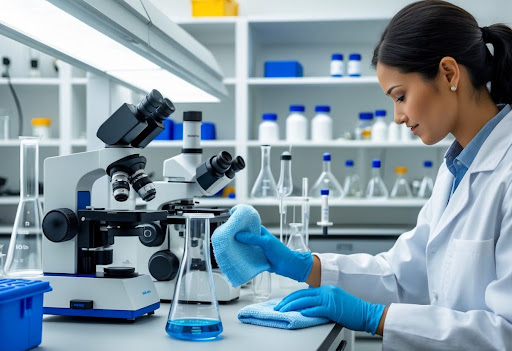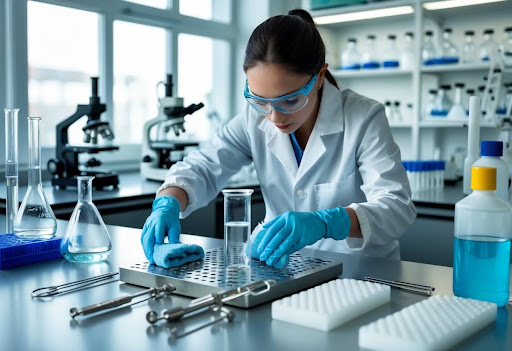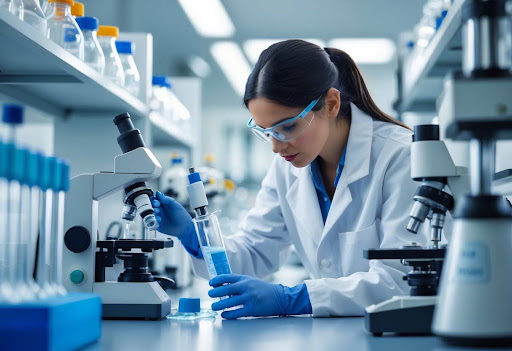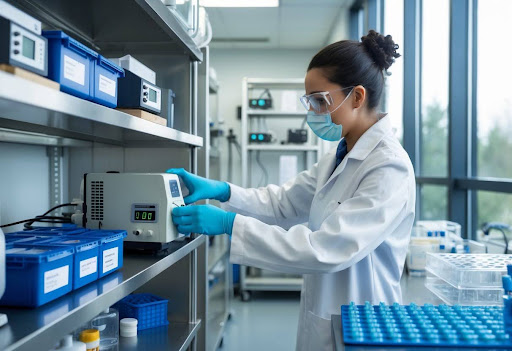Tips for Maintaining Laboratory Equipment: Best Practices for Longevity and Accuracy
Posted on: 23/06/2025
Keeping your laboratory equipment in excellent condition isn’t just about avoiding malfunctions; proper maintenance saves time, money, and ensures reliable results every day. You’ll want to make good habits like reading the equipment manual, checking for signs of wear, and performing regular cleaning with suitable personal protective equipment such as gloves and goggles.

Imagine losing valuable specimens or reagents just because a machine wasn’t routinely checked or cleaned. By inspecting for things like frayed wires or loose parts, you prevent unexpected breakdowns and extend the lifespan of your tools.
Always unplug equipment before cleaning, and keep a maintenance log so nothing gets overlooked. A straightforward checklist, paired with practical safety measures, helps you get the most dependable use out of your laboratory setup.
Consistent maintenance is essential for protecting your investment in laboratory equipment. By following proper care routines, you prevent costly problems and ensure your instruments always deliver trustworthy results.
Routine maintenance directly extends the service life of laboratory instruments, saving you money in the long run. Cleaning and lubricating moving parts can prevent corrosion and reduce general wear, especially on items such as centrifuges and microscopes.
For example, regularly changing filters on analytical devices prevents blockages and keeps internal mechanisms in good condition. Storing equipment properly, such as keeping pipettes in a vertical position, reduces physical stress and minimises the risk of malfunction.
You might consider using a maintenance log. This not only tracks cleaning and service intervals, but also highlights components that need special attention, like O-rings or seals. Proper storage, cleaning, and scheduled checks are practical tips that sustain reliability for years.
Accurate measurements are non-negotiable in any lab setting. Dust, residue, or mechanical faults can interfere with readings, leading to unreliable or invalid results. For example, balances may drift easily if not cleaned and recalibrated on a regular basis.
Following manufacturer calibration schedules is crucial for spectrophotometers, pH metres, and analytical balances. Even a slight deviation can distort your results. You should use distilled water to clean sensitive electrodes and replace buffer solutions frequently to avoid contamination.
A few practical steps for maintaining precision include:
Unplanned equipment failure can bring an experiment or entire workflow to a halt. By carrying out preventative maintenance, you reduce the chance of unexpected breakdowns and limit costly emergency repairs.
Creating a consistent schedule, even for minor items like timers or hotplates, helps you catch wear before it becomes a problem. Label frequently checked items with the date of the last inspection to establish accountability and transparency in your lab procedures.
Routine inspections allow you to spot leaks, electrical faults, or calibration drift early. Investing as little as 10 minutes each day into maintenance can result in weeks of uninterrupted operation. Replacing low-cost items like fuses, bulbs, or filters promptly also limits the need for major repairs.

Establishing a strict cleaning schedule reduces equipment breakdowns and preserves data quality. Clean equipment is safer to use, deters cross-contamination, and lengthens an instrument’s service life.
Proper daily cleaning is key for maintaining reliability. Start each day by wiping down benches, doorknobs, and exterior surfaces with a mild detergent and a damp disposable cloth. Sanitisers with at least 70% isopropyl alcohol are effective for most touchpoints in the lab.
Wash glassware immediately after use. Use warm water and an appropriate cleaning solution to remove residues. Rinse thoroughly with tap water, followed by deionised water to ensure no cleaning product remains.
Check and empty any waste or drip trays, especially those near balances and mixers. Clean behind and below the benchtop equipment where spills are common. Always let cleaned items air dry on a clean rack, avoiding towels that might harbour fibres or microbes.
For delicate electronics, dust regularly with a microfibre cloth. Inspect and record any visible damage, which you should flag for maintenance. Keep a daily cleaning log to track tasks and spot patterns in contamination or wear.
Decontamination removes or neutralises hazardous substances. Identify the material you are dealing with, biological, chemical, or radioactive, and select your method accordingly. For biological spills, use freshly prepared 10% household bleach (1 part bleach to 9 parts water). Allow a contact time of at least 10 minutes.
Chemicals often require neutralising agents. For acids, use sodium bicarbonate. For bases, try citric acid or vinegar. Always neutralise while wearing gloves, goggles, and a lab coat.
Dispose of cleaning materials in the correct waste stream, biohazard, chemical, or general rubbish. Label affected equipment as “decontaminated” with details of the process and date.
Post-decontamination, ventilate the area well. Document incidents and the actions you took. This helps maintain safe standards and supports traceability.
Handle cleaning agents with care to avoid health hazards and equipment damage. Read Material Safety Data Sheets (MSDS) before use and ensure the room is well-ventilated.
Always wear nitrile gloves, protective eyewear, and, for strong chemicals, a disposable apron. Dilute concentrated cleaning agents following product labels, never mix acid with bleach, as it releases toxic gases.
When using solvents, use a fume hood if available. Store all agents in their original, labelled containers and keep them tightly closed, away from direct sunlight and heat.
For glassware, avoid highly abrasive powders that may scratch surfaces. Instead, choose a non-abrasive, residue-free soap. Rinse cleaning implements thoroughly after use to prevent cross-contamination and prolong their usable lifetime.
Regular training ensures everyone knows proper handling procedures. Periodically review your chemical inventory to remove expired products and prevent accidental misuse.
Accurate calibration and thorough performance checks ensure your lab equipment delivers reliable results for daily operations. Regular intervals and precise monitoring protect experimental validity and support consistent, high-quality data.
Scheduled Calibration Intervals
Monitoring Equipment Accuracy


Imagine losing valuable specimens or reagents just because a machine wasn’t routinely checked or cleaned. By inspecting for things like frayed wires or loose parts, you prevent unexpected breakdowns and extend the lifespan of your tools.
Always unplug equipment before cleaning, and keep a maintenance log so nothing gets overlooked. A straightforward checklist, paired with practical safety measures, helps you get the most dependable use out of your laboratory setup.
Importance of Regular Laboratory Equipment Maintenance
Consistent maintenance is essential for protecting your investment in laboratory equipment. By following proper care routines, you prevent costly problems and ensure your instruments always deliver trustworthy results.
Ensuring Equipment Longevity
Routine maintenance directly extends the service life of laboratory instruments, saving you money in the long run. Cleaning and lubricating moving parts can prevent corrosion and reduce general wear, especially on items such as centrifuges and microscopes.
For example, regularly changing filters on analytical devices prevents blockages and keeps internal mechanisms in good condition. Storing equipment properly, such as keeping pipettes in a vertical position, reduces physical stress and minimises the risk of malfunction.
You might consider using a maintenance log. This not only tracks cleaning and service intervals, but also highlights components that need special attention, like O-rings or seals. Proper storage, cleaning, and scheduled checks are practical tips that sustain reliability for years.
Maintaining Accuracy and Precision
Accurate measurements are non-negotiable in any lab setting. Dust, residue, or mechanical faults can interfere with readings, leading to unreliable or invalid results. For example, balances may drift easily if not cleaned and recalibrated on a regular basis.
Following manufacturer calibration schedules is crucial for spectrophotometers, pH metres, and analytical balances. Even a slight deviation can distort your results. You should use distilled water to clean sensitive electrodes and replace buffer solutions frequently to avoid contamination.
A few practical steps for maintaining precision include:
- Daily calibration checks for instruments used in quantitative analysis.
- Keeping reagent and buffer stocks up to date and properly stored.
- Immediate reporting and investigation of inconsistent results.
Reducing Downtime and Repair Costs
Unplanned equipment failure can bring an experiment or entire workflow to a halt. By carrying out preventative maintenance, you reduce the chance of unexpected breakdowns and limit costly emergency repairs.
Creating a consistent schedule, even for minor items like timers or hotplates, helps you catch wear before it becomes a problem. Label frequently checked items with the date of the last inspection to establish accountability and transparency in your lab procedures.
Routine inspections allow you to spot leaks, electrical faults, or calibration drift early. Investing as little as 10 minutes each day into maintenance can result in weeks of uninterrupted operation. Replacing low-cost items like fuses, bulbs, or filters promptly also limits the need for major repairs.
Establishing Routine Cleaning Procedures

Establishing a strict cleaning schedule reduces equipment breakdowns and preserves data quality. Clean equipment is safer to use, deters cross-contamination, and lengthens an instrument’s service life.
Daily Cleaning Protocols
Proper daily cleaning is key for maintaining reliability. Start each day by wiping down benches, doorknobs, and exterior surfaces with a mild detergent and a damp disposable cloth. Sanitisers with at least 70% isopropyl alcohol are effective for most touchpoints in the lab.
Wash glassware immediately after use. Use warm water and an appropriate cleaning solution to remove residues. Rinse thoroughly with tap water, followed by deionised water to ensure no cleaning product remains.
Check and empty any waste or drip trays, especially those near balances and mixers. Clean behind and below the benchtop equipment where spills are common. Always let cleaned items air dry on a clean rack, avoiding towels that might harbour fibres or microbes.
For delicate electronics, dust regularly with a microfibre cloth. Inspect and record any visible damage, which you should flag for maintenance. Keep a daily cleaning log to track tasks and spot patterns in contamination or wear.
Decontamination Guidelines
Decontamination removes or neutralises hazardous substances. Identify the material you are dealing with, biological, chemical, or radioactive, and select your method accordingly. For biological spills, use freshly prepared 10% household bleach (1 part bleach to 9 parts water). Allow a contact time of at least 10 minutes.
Chemicals often require neutralising agents. For acids, use sodium bicarbonate. For bases, try citric acid or vinegar. Always neutralise while wearing gloves, goggles, and a lab coat.
Dispose of cleaning materials in the correct waste stream, biohazard, chemical, or general rubbish. Label affected equipment as “decontaminated” with details of the process and date.
Post-decontamination, ventilate the area well. Document incidents and the actions you took. This helps maintain safe standards and supports traceability.
Safe Handling of Cleaning Agents
Handle cleaning agents with care to avoid health hazards and equipment damage. Read Material Safety Data Sheets (MSDS) before use and ensure the room is well-ventilated.
Always wear nitrile gloves, protective eyewear, and, for strong chemicals, a disposable apron. Dilute concentrated cleaning agents following product labels, never mix acid with bleach, as it releases toxic gases.
When using solvents, use a fume hood if available. Store all agents in their original, labelled containers and keep them tightly closed, away from direct sunlight and heat.
For glassware, avoid highly abrasive powders that may scratch surfaces. Instead, choose a non-abrasive, residue-free soap. Rinse cleaning implements thoroughly after use to prevent cross-contamination and prolong their usable lifetime.
Regular training ensures everyone knows proper handling procedures. Periodically review your chemical inventory to remove expired products and prevent accidental misuse.
Calibration and Performance Verification
Accurate calibration and thorough performance checks ensure your lab equipment delivers reliable results for daily operations. Regular intervals and precise monitoring protect experimental validity and support consistent, high-quality data.
Scheduled Calibration Intervals
Set calibration intervals based on manufacturer guidelines and usage intensity rather than relying on a generic timeline. High-use instruments such as pipettes, balances, and thermometers may require quarterly or even monthly calibration, while less critical tools could be serviced annually.
Keep a digital log or use calibration management software to schedule and document calibration dates. This reduces the risk of missed calibrations and enables prompt action if an instrument drifts out of tolerance.
Pro tip: Attach calibration stickers showing the last calibration date and next due date directly on each piece of equipment. This visual reminder aids compliance during busy periods.
Consider environmental factors. For instance, temperature fluctuations or heavy-load conditions can require shorter intervals.
Monitoring Equipment Accuracy
After calibration, continuous accuracy checks are essential. Use certified reference materials, such as standard weights or control samples, to verify instrument performance between scheduled calibrations.
Record each accuracy check in a maintenance log. This habit identifies trends or sudden deviations quickly, reducing the chance of undetected errors impacting your research.
If you notice a result outside the expected range, remove the instrument from service until recalibrated. Even small inaccuracies, like a 0.01 oz (0.3 g) shift in a balance, can affect sensitive protocols.
Tip: Assign a team member to lead weekly spot checks on the most critical equipment. This extra layer of routine can catch issues before they escalate.
Proper Storage and Environmental Controls

Storing laboratory equipment in the right environment directly affects its accuracy, longevity, and safety. You must address temperature, humidity, placement, and protection to preserve sensitive tools and apparatus.
Temperature and Humidity Management
Controlling temperature and humidity helps prevent corrosion, warping, and malfunction in sensitive instruments. Aim to keep temperatures steady, ideally between 59–77°F (15–25°C), unless a specific device requires otherwise. Sudden temperature shifts may damage metal, glass, and electronic components.
Humidity should be kept below 60% RH. Excessive moisture can cause mould growth, rust, and electrical faults. For precise measurement equipment, use silica gel packs or dehumidifiers in cabinets. Monitor your storage room with a wall-mounted hygrometer and thermometer.
Keep refrigerators and freezers separate for different sample types. Never crowd equipment, as this limits airflow and affects temperature regulation. Always check calibration labels to confirm equipment is stored under optimal conditions.
Safe Equipment Placement
Arranging equipment safely minimises the risk of accidents, cross-contamination, and physical damage. Store heavy items on lower shelves to prevent falls and injuries. Use clearly labelled shelves and cabinets, so you can locate items quickly without unnecessary handling.
Keep glassware and chemical-sensitive devices away from direct sunlight and vibration sources like centrifuges or heavy HVAC vents. For delicate equipment, dedicated padded containers or foam-lined drawers offer extra safety. Frequently used items should be easy to reach at bench level, while rarely used or hazardous tools can be secured under lock and key.
Always follow manufacturer-recommended guidelines for storage orientation; some pipettes, for example, must be stored vertically to prevent liquid ingress.
Protection from Contaminants
Preventing contamination is vital for both safety and data accuracy. Store equipment in clean, dry, dust-free areas. Use plastic covers, dust shields, or enclosed cabinets for analytical balances, microscopes, and spectrophotometers.
After use, always clean the equipment according to protocol before returning it to storage. Avoid storing clean and used items together. Use marked containers for reagents and regularly check expiration dates. For biohazard-prone tools, separate them in sealed and labelled bins, far from general-purpose areas.
Quick tip: Place adhesive mats at entrances to storage areas to reduce the spread of particulate contaminants. Routine housekeeping and prompt spill management help maintain a pristine storage environment.
Training Laboratory Personnel
Proper training for laboratory personnel ensures equipment is handled safely, reducing wear and preventing accidents. Investing in skills and knowledge limits errors and streamlines routine maintenance tasks.
Comprehensive Equipment Handling Training
You should start by ensuring all new staff receive hands-on training for each piece of equipment they use. Reading the manual is crucial, but practical demonstrations reinforce best practices. Encourage trainees to practise common procedures, such as proper start-up, shut-down, and cleaning routines.
Provide checklists so staff can verify steps are followed. For example, always disconnect electrical units before cleaning, and wear gloves and goggles when handling hazardous chemicals. Some equipment, like centrifuges and spectrophotometers, require extra care during assembly or disassembly.
Regular reminders about the consequences of mishandling, such as inaccurate results or equipment breakdowns, emphasise the importance of correct techniques. A simple tip: create laminated guides near each station as quick references.
Ongoing Skills Development
You need to keep your team up to date with periodic refresher sessions. Schedule annual workshops to address any changes in standard operating procedures (SOPs) and introduce new technologies. Use quizzes and case studies to test knowledge and address gaps.
Encourage staff to bring up issues they encounter, as sharing real-life examples benefits everyone. Set up a logbook for recording maintenance activities, including unexpected errors or malfunctions. Tracking this information helps identify recurring problems and trains staff on troubleshooting.
Offer incentives for exemplary record-keeping or equipment care. Continual learning builds confidence and expertise, leading to fewer equipment failures and extending the life of essential lab tools.
Frequently Asked Questions







